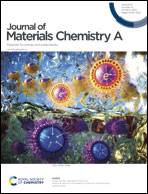From vanadium slag to multi-cation-intercalated V2O5·nH2O: low-cost direct synthesis and high-performance aqueous battery application†
Abstract
Although hydrated vanadate compounds have received extensive attention in aqueous batteries due to their high specific capacity, they are still impeded by the poor cycling resulting from host structure degradation and metal dendrite formation. Herein, we prepare multi-ion co-pre-intercalated hydrated vanadate microflowers (MxVO) with a robust crystal structure from vanadium slag waste, presenting highly reversible and ultrafast Zn2+ storage. Furthermore, using diethyl ether as the electrolyte additive, the cycling durability of zinc metal can be improved and the cells can work well at −20 °C. Impressively, the MxVO cathode realizes an unparalleled rate capability (203 mA h g−1 at 100 A g−1) and excellent cycling stability (317 mA h g−1 after 4000 cycles at 20 A g−1). Even when tested at −20 °C, it demonstrates a satisfactory zinc storage capability (e.g., the coin-type cell shows a discharge capacity of 120 mA h g−1 at 50 A g−1, and the pouch cell delivers ∼200 mA h g−1 at 1 A g−1). Hence, this work has exploited a new and efficient avenue for the exploration and utilization of solid waste toward high-performance aqueous batteries and other electrochemical applications.



 Please wait while we load your content...
Please wait while we load your content...